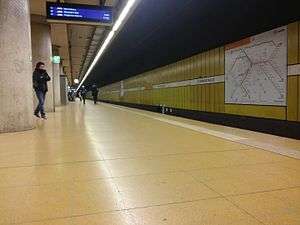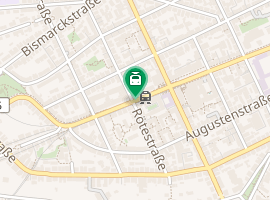Stuttgart Schwabstraße station
Schwabstraße underground station is in Stuttgart-West district, west of the centre of the German city of Stuttgart and was at the end of the first section of the Connection line (German: Verbindungsbahn), the original underground section of the Stuttgart S-Bahn. Several lines of the S-Bahn terminate at the station. It is notable for a 1.5 km long loop at the end of the station to allow S-Bahn trains to turn around.
| Through station | |||||||||||||||||||||||||||||||||||||||||
 View of track 1 | |||||||||||||||||||||||||||||||||||||||||
| Location | Rotebühlstrasse, Stuttgart, Baden-Württemberg Germany | ||||||||||||||||||||||||||||||||||||||||
| Coordinates | 48°46′13″N 9°09′24″E | ||||||||||||||||||||||||||||||||||||||||
| Owned by | Deutsche Bahn | ||||||||||||||||||||||||||||||||||||||||
| Operated by | |||||||||||||||||||||||||||||||||||||||||
| Line(s) | Verbindungsbahn (Stuttgart) (KBS 790.x) | ||||||||||||||||||||||||||||||||||||||||
| Platforms | 1 island platform | ||||||||||||||||||||||||||||||||||||||||
| Tracks | 2 | ||||||||||||||||||||||||||||||||||||||||
| Train operators | S-Bahn Stuttgart | ||||||||||||||||||||||||||||||||||||||||
| Connections | S 1 S 2 S 3 S 4 S 5 S 6 S 60 | ||||||||||||||||||||||||||||||||||||||||
| Other information | |||||||||||||||||||||||||||||||||||||||||
| Station code | 6083[1] | ||||||||||||||||||||||||||||||||||||||||
| DS100 code | TSS[2] | ||||||||||||||||||||||||||||||||||||||||
| IBNR | 8006698 | ||||||||||||||||||||||||||||||||||||||||
| Category | 3[1] | ||||||||||||||||||||||||||||||||||||||||
| Fare zone | |||||||||||||||||||||||||||||||||||||||||
| Website | www.bahnhof.de | ||||||||||||||||||||||||||||||||||||||||
| History | |||||||||||||||||||||||||||||||||||||||||
| Opened | 1 October 1978 | ||||||||||||||||||||||||||||||||||||||||
| Services | |||||||||||||||||||||||||||||||||||||||||
| |||||||||||||||||||||||||||||||||||||||||

| |||||||||||||||||||||||||||||||||||||||||
| Location | |||||||||||||||||||||||||||||||||||||||||
 Stuttgart Schwabstraße Location in Baden-Württemberg  Stuttgart Schwabstraße Location in Germany  Stuttgart Schwabstraße Location in Europe | |||||||||||||||||||||||||||||||||||||||||
.png)
History
Schwabstraße station was built in the course of the construction of the Stuttgart S-Bahn in the mid-1970s. The station was built using excavation from the surface and mining techniques for the terminal loop. Its construction proved to be very difficult. The shell was completed in December 1977[4] and in 1978 the first section of the Connection line began operating to Schwabstraße. In 1985, line was extended to the southwest to Stuttgart University station at the University of Stuttgart.
Station
The station is between 11 and 27 m below the street surface, lying 6 to 8 metres below the water table. It has a gradient of 1.6 per thousand. The station has an island platform with two platform edges. Platform track 1 serves trains towards Stuttgart Universität and trains terminating at Schwabstraße. Track 2 serves trains running to Stuttgart Hauptbahnhof. Access routes to the platform are at either end of the platform. At the western end of the platform the tracks to the turning loop separate from the through tracks towards Universität.
Terminal loop
The station has an unusual operational feature, a turning loop. It runs completely underground and contains a siding for a full train. The depth of the ground covering the tunnel ranges from 17 m near the platforms to 80 m at its western end near the former Stuttgart West station. Given the number of trains using the line, a return loop was found to have a higher economic return than simple terminating tracks despite the higher construction costs.[5]
Excavation of the loop began on 7 October 1974 and the construction of the junction structures and the first 60 m sections of the two single-track tunnel tubes of the Hasenberg Tunnels towards the Gäu Railway (Gäubahn). The actual connection to the Gäu Railway was built in 1979 and went into operation in 1985.
The front of the terminal loop is in leached Gipskeuper rock. Because this is fragile and the depth of rock is low, the rock above the tunnel roof was made stable by freezing it. There was a geological problem as the back of the terminal loop was situated in Gipskeuper layers containing anhydrite, which swell strongly when in contact with water, which is inevitable in a tunnel, and create strong forces on the sides of the tunnel. Accordingly, the inner shell of the tunnel is up to 1 m thick.
The tunnel section has an inner diameter of 6.70 m on single-track sections and 9.80 m on two-track sections. The radius of the loop is 190 m and its length is 1,500 m.[6]
Operations
The station's abbreviation is TSS. The station is in the fare zone of the Verkehrs- und Tarifverbund Stuttgart (transport and tariff association of Stuttgart). The station is classified by Deutsche Bahn as a category 3 station.[1]
S-Bahn
| Line | Route |
|---|---|
| S 1 | Kirchheim (Teck) – Wendlingen – Plochingen – Esslingen – Neckarpark – Bad Cannstatt – Hauptbahnhof – Schwabstraße – Vaihingen – Rohr – Böblingen – Herrenberg |
| S 2 | Schorndorf – Weinstadt – Waiblingen – Bad Cannstatt – Hauptbahnhof – Schwabstraße – Vaihingen – Rohr – Stuttgart Flughafen/Messe – Filderstadt |
| S 3 | Backnang – Winnenden – Waiblingen – Bad Cannstatt – Hauptbahnhof – Schwabstraße – Vaihingen – Rohr – Flughafen/Messe |
| S 4 | Schwabstraße – Hauptbahnhof – Zuffenhausen – Ludwigsburg – Marbach – Kirchberg (Murr) – Burgstall (Murr) – Backnang |
| S 5 | Schwabstraße – Hauptbahnhof – Zuffenhausen – Ludwigsburg – Bietigheim |
| S 6 | Schwabstraße – Hauptbahnhof – Zuffenhausen – Leonberg – Weil der Stadt |
| S 60 | Schwabstraße – Hauptbahnhof – Zuffenhausen – Leonberg – Renningen – Magstadt – Maichingen – Sindelfingen – Böblingen |
References
- "Stationspreisliste 2020" [Station price list 2020] (PDF) (in German). DB Station&Service. 4 November 2019. Retrieved 15 November 2019.
- Eisenbahnatlas Deutschland (German railway atlas) (2009/2010 ed.). Schweers + Wall. 2009. ISBN 978-3-89494-139-0.
- "Tarifzoneneinteilung" (PDF). Verkehrs- und Tarifverbund Stuttgart. 1 April 2020. Retrieved 16 April 2020.
- Jürgen Wedler, Karl-Heinz Böttcher: Der Tunnel. Verbindungsbahn der S-Bahn Stuttgart. Dokumentation ihrer Entstehung. Herausgegeben von der Bundesbahndirektion Stuttgart. Kohlhammer Verlag, Stuttgart 1985, ISBN 3-925565-01-9, p. 100–104.
- Jürgen Wedler, Karl-Heinz Böttcher: Der Tunnel. Verbindungsbahn der S-Bahn Stuttgart. Dokumentation ihrer Entstehung. Herausgegeben von der Bundesbahndirektion Stuttgart. Kohlhammer-Verlag, Stuttgart 1985, ISBN 3-925565-01-9, p. 19-20.
- Günter Dutt (1996). "Ein Streifzug durch 150 Jahre Tunnelbauwerke in Württemberg". Jahrbuch für Eisenbahngeschichte (in German). Lübbecke: Uhle & Kleimann. pp. 47–63. ISSN 0340-4250.
External links
- "Stuttgart Schwabstraße station" (in German). Deutsche Bahn. Retrieved 31 March 2011.
- "Station plan" (PDF) (in German). Verkehrs- und Tarifverbund Stuttgart. Retrieved 31 March 2011.